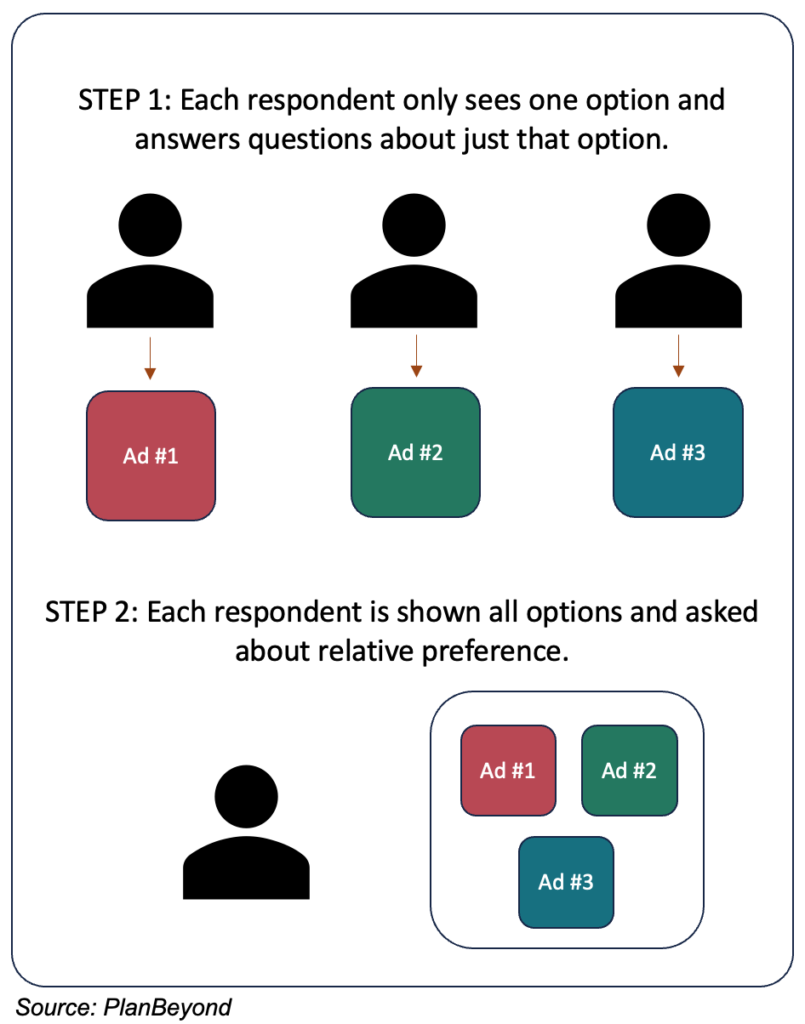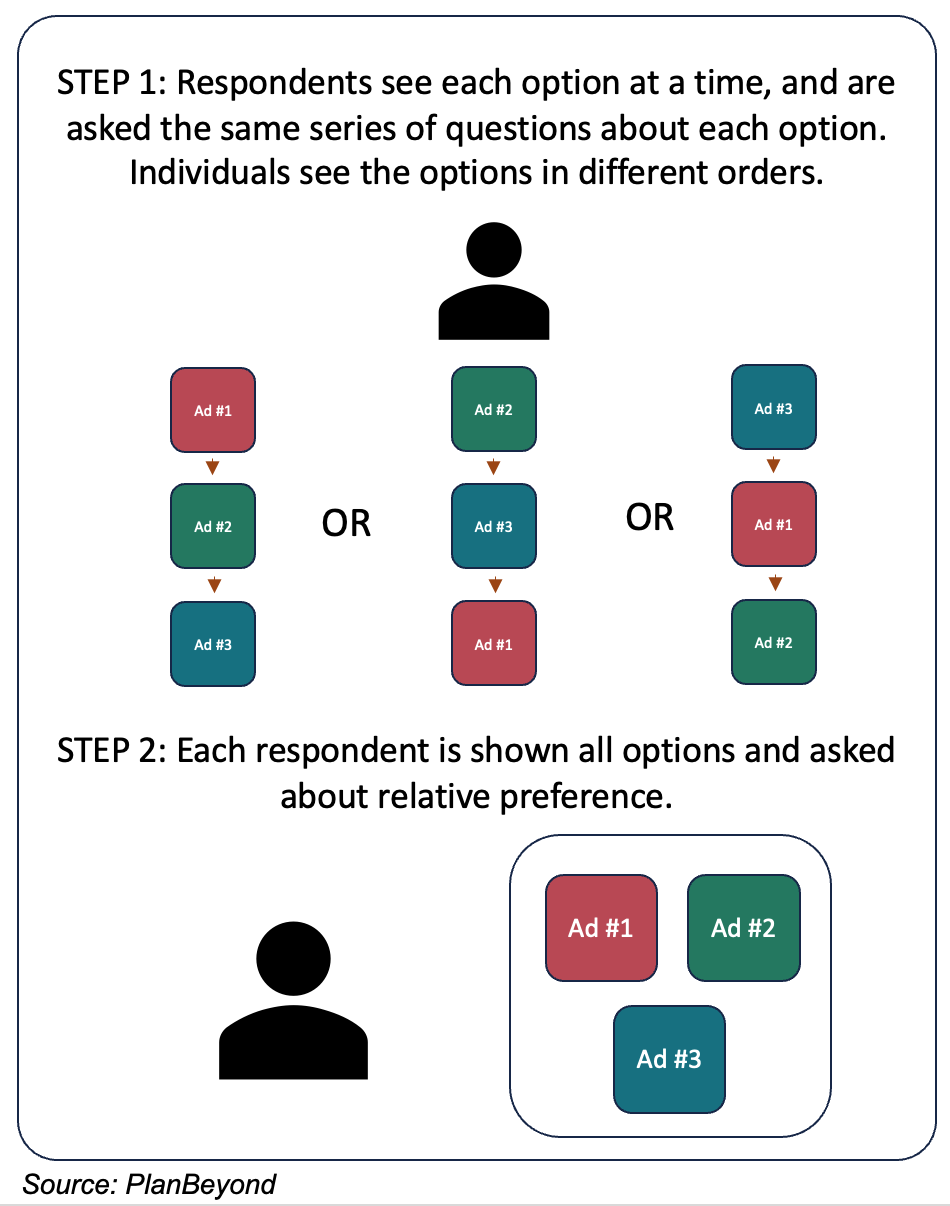Don’t you want to put the best ad content in front of your customers? After all, many organizations spend at least 10% of their revenue on marketing. That’s a lot of money to lose if your advertising falls flat.
It’s a key reason organizations allocating significant budget to their media fees often perform advertising testing. By pinpointing which advertising improves brand recall and product interest, these organizations confidently put the best, most compelling advertising in market.
What Is Advertising Testing
Advertising testing is a way to objectively evaluate your advertising with individuals that represent your target customer. It gives organizations a way to see how well an ad meets specific criteria and if it resonates with a target market.
In fact, advertising testing has been shown to improve ad efficacy by at least 20%. This is because advertising testing lets you examine what elements are working so you can refine them further. And, it lets you see what isn’t working so you can adjust it or remove it entirely.
Once thing to keep in mind about ad testing is that it does not require you to have final ad creatives. Clean storyboards, or even animated sketches, work well for this purpose. Creative elements that are easy-to-understand, and that represent how you plan to bring the ads to life, work great for this purpose. They give respondents something compelling to review without organizations spending too much time or money in advance.
What Should You Measure In Ad Testing
Because brands could stand for so many things, you’ll likely want a wide variety of dimensions included in your advertising testing. Nevertheless, we usually see a few dimensions in just about any ad research project.
- Brand Recall: Advertising is (usually) tied to a specific brand or organization. Good advertising should help seed that brand in customers’ minds. Be sure to test if people remember the brand they saw in the ad.
- Purchase Intent: Advertising is about getting people to buy your product. Be sure to include measures to see if the ads drive a likelihood to buy.
- Message Relevance: Effective marketing means targeting the right audience with the right message. You’ll want to test if the messaging strikes a positive chord with your audience.
- Appeal: You can have the right message geared to the right audience, but not communicate it in a way that resonates with them. Measuring appeal helps gauge if tone, style, and approach also strike a chord.
On top of the four dimensions mentioned above, we also see the dimensions below in many of our projects as well.
- Believability: Advertising making specific claims must be believable. Test to see if any claims being made are trusted by your target audience.
- Call To Action: If you want your audience to do a certain behavior as a result of seeing your ads, you’ll have to measure if that idea is coming through.
- Uniqueness: If your aim is to really stand out from the pack, measure if your ads, and the products within them, come across as unique or different.
After this batch of dimensions comes elements that sync directly to what your product does. For instance, brands in health and wellness may want to include dimensions for trust and efficacy. Meanwhile, brands in the food and beverage space could include dimensions around taste, texture, and being nutritious.
In essence, the goals you had in place when creating your ads should be how you think about what to measure when doing your advertising testing.
How To Perform Advertising Research
Let’s look at the standard approach for homing in on the best advertising for your brand.
Step 1: Isolate Who You Want In Your Study. When we recruit participants into a study, we first need to determine who our target audience is. Advertising feedback should only come from individuals that look like your ideal customer.
That said, you may want to see if any of your advertising creatives appeal to additional market segments. Or, if they potentially alienate any segments. If so, we broaden who is recruited into the study to get this additional level of insight.
Step 2: Develop Your Advertising Stimuli. It likely goes without saying but we cannot do advertising testing without the advertising itself. As we mentioned above, these could be as simple as storyboard mockups or as complete as final live-action ads. Just be sure they are crisp and clean enough to be easily reviewed by your test audience.
Step 3: Define Your Research Approach. With your audience and advertising stimuli in place, it’s now time to test it. There are a lot of ways to put together advertising testing projects. But, there are two standard approaches.
Option A: Monadic Testing. Don’t be alarmed by this fancy-sounding term. Monadic simply means that participants see just one advertising creative. Depending on what you want to test, this means they see one storyboard or one 30-second ad spot. They then answer a series of questions about what they saw.
You could also allow them to see all of the creatives you have at the very end and ask for their preferred ad creative.
Let’s talk about the pros of this option:
- Unbiased Responses: In monadic testing, respondents see just one isolated concept. They don’t know what other advertising you may have. This lets them give you clean, unbiased answers.
- Probing Follow Ups: Because monadic tests focus on just one advertising creative, you can ask a lot of follow up questions. This lets you probe on a wide array of dimensions while still reigning in the amount of time required of respondents.
Now, let’s talk about the cons of this option:
- Large Sample Sizes: You need enough people in your study to build statistically significant reads. This means recruiting a large sample so that you can split them up across all of your advertising concepts.
- Difficulty With Niche Audiences: If your target audience is fairly small or niche, you already have challenges finding them. This means you may not be able to get the sample sizes you need for this type of approach.


Approach 2: Sequential Monadic Testing. Unlike a monadic test, a sequential monadic test shows each respondent each advertising creative in sequence. Respondents see the creative and answer a series of questions about that creative. They then repeat this process across all of the advertising you want to test. And, we almost always randomize the order in which respondents see the creatives to minimize bias.
Just as with the monadic test, we can also ask respondents to select their preferred option at the end.
Let’s talk about the pros of this option:
- Smaller Sample Size Requirements: This approach requires each respondent to see every advertising creative. This means gathering more feedback per respondent. As a result, we need to recruit fewer individuals into our study.
- Better For Niche Audiences: This approach lets us get away with smaller sample sizes. This is ideal when reaching niche audiences that are hard to recruit.
Now, let’s talk about the cons of this option:
- Longer Survey Duration: Sequential monadic tests require each respondent to see each advertising creative. And, it requires them to answer the same series of questions about those creatives. This means this type of study is longer to complete, sometimes yielding higher survey drop out rates.
- Fewer Deep-Dive Questions: To manage survey duration, we often limit the number of questions we ask about any given advertising creative. This means we get less intel about each option.
How To Select The Best Advertising
Sometimes, one ad rises to the top by receiving high scores across all dimensions. More often than not, it’s not so simple. One ad may perform strongly for some dimensions while another performs strongly for others.
When faced with this more ambiguous situation, we ask our clients to tell us which dimensions they prioritize over others. For instance, in extremely crowded categories, developing advertising that comes across as “unique” or “different” may be a major priority. In contrast, brands geared toward health and safety may need dimensions like “trust” be come out loud and clear.
Determine which elements are most important to your brand. With that in mind, you’ll be able to break these ties and select the best option for your business.






